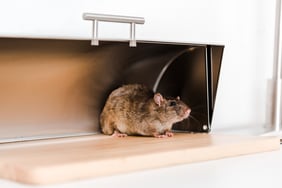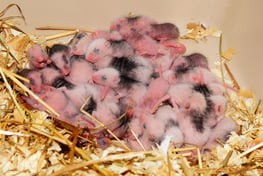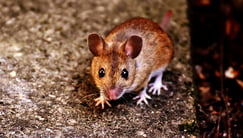Mice are common household pests for the typical homeowner, and as such, they are a major concern for homeowners. Prolific reproducers and capable of truly disastrous damage to homes, it’s not surprising that we encounter many questions about mice. Why do I have mice in my home? How can I keep mice out? What are some signs of a mouse infestation? Then there are the questions from seasoned homeowners who notice near silence during the day, followed by a sudden flurry of mouse activity at night. These homeowners often ask: where do mice hide during the day?


What do I need to know about mice?
To better understand the day-to-day activity of mice, it’s crucial to understand mice themselves.
Mice are small rodent mammals of the Muroidea superfamily. Sometimes confused with rats, mice are characteristically smaller in size than rats and are easily recognized by their pointed snout, rounded ears, and long tails. Some of the more commonly encountered mice include the aptly named house mouse, deer mouse, and white-footed mouse. All three of these mice are known for their tendency to frequent homes and personal residences. Unfortunately for homeowners, these mice, like all mice, reproduce at incredibly prolific rates. The rapid reproduction of mice should be cause for concern when you find one in your home – chances are, if there truly is just one mouse in your house, there will be many more before long.

What is a mouse’s lifecycle?
Not only do mice reproduce expeditiously, but they can also live for a considerable amount of time if living safely indoors. Once a female mouse becomes pregnant, she will give birth in just three short weeks. Each litter can contain up to eight “pups,” and females may reproduce as many as ten times per year. The baby mice will reach maturity and be able to reproduce themselves within two months after being born. This cycle of reproduction will continue for the entirety of a mouse’s lifespan, which is approximately 2-3 years on average. Needless to say, this spells trouble for homeowners with a mouse problem.
Why do mice come inside my home in the first place?
Mice are particularly drawn to certain areas within a home, such as garages, ceilings, inside walls, under kitchen cabinets or fridges, and in basements or crawl spaces. These mouse “hot spots” can help determine why mice have decided to take up residence in your home. What attracts mice to heavily trafficked and clearly occupied homes? Why do they choose to stay, live, and even reproduce in homes? And why can’t you get rid of them?
While there are seemingly limitless reasons why a mouse may enter your home or garage, there are a few broadly defined causes for unwelcome rodent visitors.
- Food - Whether you realize it or not, you could be unintentionally feeding the mice that make their way into your home. This is one major reason mice tend to seek out residences: unlimited food supply. Mice are hardy little creatures and can easily survive off of unnoticed crumbs and food scraps, or worse, make their way into your kitchen pantry for the real buffet. Mice are also known to help themselves to bags of grain, birdseed, grass seed, pet food, or other bulk food items that you may store in your garage. They may squeeze their way into your car in search of trash like half-empty takeout bags or dropped morsels from your morning's grab-and-go breakfast.
- Water - Your home can be a reliable water source for mice. With so many rooms having access to readily available water – think kitchens, bathrooms, laundry rooms, and even garages – mice will never have to stray from the home for a quick drink. Mice can go a month or more without water, and even with easily accessible water available to them, they only need about 4ml to be quenched. Because they need so little water, they can survive by finding it in unexpected ways, such as by drinking condensation from water pipes, consuming excess water from houseplants, and helping themselves to a pet’s water bowl. This means that no matter how watertight you believe your home is, a mouse can still thrive.
- Shelter - The most obvious reason that mice scurry indoors is for shelter from predators and the elements. In the summertime, mice will seek shelter for a reprieve from the heat. As we cool our homes for our own comfort throughout the summer, we’re unintentionally providing a temperature-controlled environment perfect for mice to find relief in. The same can be said for the winter. Consistently warmed homes offer an escape for mice from the bitter cold and provide an excellent home base for building their nests. The constant need for comfortable and safe shelter is exactly why mice are not considered a seasonal pest but rather a year-round one. This is especially true for homes with garages, where mice can live undetected for a long time and find plenty of dark places to hide and nest.
Why are mice most active during the night?
Many believe mice to be nocturnal creatures, but this is neither true nor untrue. A mouse’s sleep patterns depend entirely on its environment; mice opt to sleep when danger is least likely to be present and remain active during heightened periods of potential danger. For mice in the wild, this often means they will be most active during the very early hours of the morning when predators are either asleep or have limited visibility due to the lack of light. Mice residing inside someone’s home perceive the homeowners as a threat (ironic, we know) and therefore, will lay low during the day when we are up and about. This is one of the reasons that homeowners will report increased mouse activity - sightings or sounds - as it approaches our “bedtime.”
In addition, mice also have very weak eyesight and are sensitive to bright lights. This could also explain why we rarely witness mice in our homes during the daylight hours when the sun is pouring through windows or lights are flicked on. Mice prefer darkness as they rely on their sense of touch and smell to navigate efficiently around our homes.

Where are mice hiding during the day?
Mice will frequently stick very close to their nests during their inactive hours, making themselves scarcely seen or heard. A mouse’s territory is small in general; they rarely travel more than 10-30 feet from their nests for food or drink, so if you happen to witness one, their nest is likely very close by. During a mouse’s inactive hours, they remain cozied up in their nests, sleeping or otherwise resting. Did you know mice sleep up 14 hours a day? It’s no wonder there are often long stretches of time between hearing or seeing a mouse in your home. Almost long enough for you to wistfully imagine they have left your house once and for all… (unlikely, without the proper pest control solutions.)
Where do mice build their nests?
Mice have relatively low standards for living quarters - anywhere somewhat dark, warm, and away from humans will do. By these standards, that leaves a LOT of places for mice to build nests. Mice will build nests in wall voids, ceilings, garages, attics, crawl spaces, under refrigerators/stoves/dishwashers, and even in boxes or drawers if given the chance. Oftentimes the nest is difficult to locate, sometimes inaccessible to humans altogether.
If accessible, mouse nests themselves are identifiable by their ball-like appearance with a single entrance and exit point. Mice use a variety of materials to build their nests, much of which they've likely taken from within your residence. Anything soft or pliable is perfect material for mice to construct their nests. Materials include paper, fiberglass insulation, string, mattress batting, tissues, and even foliage from houseplants are some common mouse favorites. Damage to the home or personal items is common when mice are constructing their nests.

What does a mouse infestation look like?
Before stumbling on a mouse's nest, you likely have witnessed some signs of an infestation. Mice tend to be pretty conspicuous intruders despite their small size. Here are some telltale signs that you've got a mouse infestation in your home:
- Droppings: mouse excrement looks like small, dark pellets and is often plentiful. Mice can leave anywhere from 50-80 droppings in a single night.
- Grease marks: mice and other rodents can leave dark smears along frequently traveled routes in your home as their body brushes up against the walls or baseboards routinely.
- Urine pillars: in well-established or severe infestations, a collection of grease, dirt, and urine can create small mounds up to 4cm high.
- Scratching sounds: mice are most active during the night, which is convenient when our own activity tends to die down. During a mouse infestation, you'll likely be able to hear scratching and skittering in your ceiling, walls, floorboards, attic, or garage at nighttime.
- Strong smell: mice urine is incredibly pungent and ammonia-like in scent. You may be able to smell this if you are near a nest or in an area of high activity. The scent can also linger well after an infestation has been rectified.
How can I remove mice from my home?
There are a multitude of products on the market that claim to get rid of mice quickly. These products can have varying degrees of effectiveness and rarely offer a long-term solution to mouse problems. Some of these solutions include:
- Repellants
- Bait traps
- Live traps
- Ultrasonic deterrent devices
- Spray application methods
In general, we advise against DIY methods of mice removal for a variety of reasons. DIY methods can often be ineffective or only temporarily effective, potentially dangerous (especially to children and pets!), and often expensive in the event that removal requires several attempts.
For reliable mice removal, we recommend contacting a reputable pest control company such as EcoShield at the first sign of a mouse in your home. EcoShield’s proven and guaranteed 3-step process addresses mice infestations holistically and provides protection for not only the current problem but future problems, as well.
EcoShield's exclusion services are an effective solution to eliminate mouse and rodent infestations, by removing and treating existing infestations and by also sealing and repairing entry points to prevent mice from continuing to enter your home.
If you are experiencing problems with mice in your home, give EcoShield a call today or fill out the form at the bottom of this page. Our experts are ready to help remove mice and ensure your home stays pest-free for the ultimate health and safety of you and your loved ones.